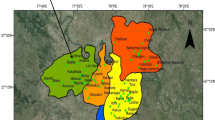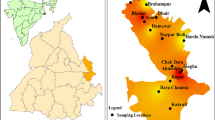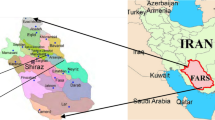Abstract
This research focuses on the assessment of fluoride doses in groundwater adopting the mathematical model employed by the USEPA. A total of 456 groundwater samples were tested to assess the spatial distribution of fluoride contamination in the study areas. Three age groups (children, teens and adults) were selected for two-way pathway exposure (potential dose and dermal dose) assessment. For uncertainty and sensitivity of inputs variables, a new emerging Sobol sensitivity analysis (SSA) technique was used to determine the relative importance of inputs using Monte Carlo simulation. Three types of effects, first-order effect (FOE), second-order effect (SOE) and total effect (TE) were calculated. The results showed that 96% of the samples analysed were within the standard acceptable level (1.5 mg l−1) of WHO guidelines. The spatial distribution depicts that the eastern and south-eastern parts of the study area have the higher concentrations with the few spots of elevated concentration in the middle of the north and the south-west areas. The mean value of Hazard Index for children in the study region is less than 1, whereas the 95th percentile exceeded the value of 1 for both children and teens. The FOE shows the concentration of fluoride (Cw) is highly sensitive followed by exposure frequency (EF), intake rate (IRw) and body weight (BW). The SOE scores revealed that IRw–BW are the most important input parameters for the assessment of oral health risk. For the dermal model, the highest value of Sobol score was recorded for interactions Cw–SA for adults followed by teens and children. Further, the results show that the older-age groups have more dermal risk than the younger-age groups. The research explores the feasibility of SSA technique to investigate the effects of individual input parameters for health risk model and whether it can be applied to another contaminant.





Similar content being viewed by others
References
Adimalla N (2018) Groundwater quality for drinking and irrigation purposes and potential health risks assessment: a case study from semi-arid region of South India. Expo Health. https://doi.org/10.1007/s12403-018-0288-8
Adimalla N, Venkatayogi S (2017) Mechanism of fluoride enrichment in groundwater of hard rock aquifers in Medak, Telangana State, South India. Environ Earth Sci 76:45
Adimalla N, Li P, Qian H (2018a) Evaluation of groundwater contamination for fluoride and nitrate in semi-arid region of Nirmal Province, South India: a special emphasis on human health risk assessment (HHRA). Hum Ecol Risk Assess. https://doi.org/10.1080/10807039.2018.1460579
Adimalla N, Vasa SK, Li P (2018b) Evaluation of groundwater quality, Peddavagu in Central Telangana (PCT), South India: an insight of controlling factors of fluoride enrichment. Model Earth Syst Environ 4:841–852
Akiniwa K (1997) Re-examination of acute toxicity of fluoride. Fluoride 30:89–104
Apambire W, Boyle D, Michel F (1997) Geochemistry, genesis, and health implications of fluoriferous groundwaters in the upper regions of Ghana. Environ Geol 33:13–24
APHA (2005) Standard methods for the examination of water and wastewater. American Public Health Association (APHA), Washington, DC
Baghania AN, Mahvib AH, Rastkaric N, Delikhoond M, Hosseinie SS, Sheikhif R (2017) Synthesis and characterization of amino-functionalized magnetic nanocomposite (Fe3O4-NH2) for fluoride removal from aqueous solution. Desalin Water Treat 65:367–374
Barbier O, Arreola-Mendoza L, Del Razo LM (2010) Molecular mechanisms of fluoride toxicity. Chem Biol Interact 188:319–333
Bassin EB, Wypij D, Davis RB, Mittleman MA (2006) Age-specific fluoride exposure in drinking water and osteosarcoma (United States). Cancer Causes Control 17:421–428
Beg M, Srivastav S, Carranza E, de Smeth J (2011) High fluoride incidence in groundwater and its potential health effects in parts of Raigarh District, Chhattisgarh, India. Curr Sci 100:750–754
Chakraborti D, Das B, Murrill MT (2010) Examining India’s groundwater quality management. Environ Sci Technol 45(1):27–32
Chilton J et al (2006) Fluoride in drinking-water. World Health 408:613–693
Choi AL et al (2015) Association of lifetime exposure to fluoride and cognitive functions in Chinese children: a pilot study. Neurotoxicol Teratol 47:96–101
Cooper C, Wickham CA, Barker DJ, Jacobsen SJ (1991) Water fluoridation and hip fracture. Jama 266:513–514
Cronin AA, Prakash A, Priya S, Coates S (2014) Water in India: situation and prospects. Water Policy 16:425–441
Dehghani MH, Faraji M, Mohammadi A, Kamani H (2017) Optimization of fluoride adsorption onto natural and modified pumice using response surface methodology: isotherm, kinetic and thermodynamic studies. Korean J Chem Eng 34:454–462
Edmunds WM, Smedley PL (2013) Fluoride in natural waters. Essentials of medical geology. Springer, Berlin, pp 311–336
Epa U (2011) Exposure factors handbook 2011 edition (final). US Environmental Protection Agency, Washington, DC
Felsenfeld AJ, Robert M (1991) A report of fluorosis in the United States secondary to drinking well water. J Am Med Assoc 265:486–488
He S, Wu J (2018) Hydrogeochemical characteristics, groundwater quality and health risks from hexavalent chromium and nitrate in groundwater of Huanhe Formation in Wuqi County, northwest China. Expo Health 5:9. https://doi.org/10.1007/s12403-018-0289-7
He X, Wu J, He S (2018) Hydrochemical characteristics and quality evaluation of groundwater in terms of health risks in Luohe aquifer in Wuqi County of the Chinese Loess Plateau, northwest China. Hum Ecol Risk Assess. https://doi.org/10.1080/10807039.2018.1531693
Homma T, Saltelli A (1996) Importance measures in global sensitivity analysis of nonlinear models. Reliab Eng Syst Saf 52:1–17
Huang D, Yang J, Wei X, Qin J, Ou S, Zhang Z, Zou Y (2017) Probabilistic risk assessment of Chinese residents’ exposure to fluoride in improved drinking water in endemic fluorosis areas. Environ Pollut 222:118–125
IPCS (2012) Environmental health criteria 227: fluorides Effects of ingested fluoride. National Academy Press, Geneva
Jacks G, Bhattacharya P, Chaudhary V, Singh K (2005) Controls on the genesis of some high-fluoride groundwaters in India. Appl Geochem 20:221–228
Jacobson J, Weinstein L (1977) Sampling and analysis of fluoride: methods for ambient air, plant and animal tissues, water, soil and foods. J Occup Environ Med 19:79–87
Karami A et al (2017) Application of response surface methodology for statistical analysis, modeling, and optimization of malachite green removal from aqueous solutions by manganese-modified pumice adsorbent. Desalin Water Treat 89:150–161
Karthikeyan G, Shunmugasundarraj A (2000) Isopleth mapping and in situ fluoride dependence on water quality in the Krishnagiri block of Tamil Nadu in South India. Fluoride 33:121–127
Khorsandi H, Mohammadi A, Karimzadeh S, Khorsandi J (2016) Evaluation of corrosion and scaling potential in rural water distribution network of Urmia, Iran. Desalin Water Treat 57:10585–10592
Kohn WG, Maas WR, Malvitz DM, Presson SM, Shaddix KK (2001) Recommendations for using fluoride to prevent and control dental caries in the United States. Morbid Mortal. Wkly Rep. 50, No. RR-14. http://www.cdc.gov/mmwr/
Kumar S, Lata S, Yadav J, Yadav J (2017) Relationship between water, urine and serum fluoride and fluorosis in school children of Jhajjar District, Haryana, India. Appl Water Sci 7:3377–3384
Kumar D, Singh A, Jha RK, Sahoo SK, Jha V (2018) Using spatial statistics to identify the uranium hotspot in groundwater in the mid-eastern Gangetic plain, India. Environ Earth Sci 77:702
Li P, Qian H, Wu J, Chen J, Zhang Y, Zhang H (2014) Occurrence and hydrogeochemistry of fluoride in shallow alluvial aquifer of Weihe River, China. Environ Earth Sci 71(7):3133–3145
Li P, Li X, Meng X, Li M, Zhang Y (2016) Appraising groundwater quality and health risks from contamination in a semiarid region of northwest China. Expo Health 8(3):361–379. https://doi.org/10.1007/s12403-016-0205-y
Li P, He X, Li Y, Xiang G (2018) Occurrence and health implication of fluoride in groundwater of loess aquifer in the Chinese Loess Plateau: a case study of Tongchuan. Expo Health, Northwest China. https://doi.org/10.1007/s12403-018-0278-x
Maithani P, Gurjar R, Banerjee R, Balaji B, Ramachandran S, Singh R (1998) Anomalous fluoride in groundwater from western part of Sirohi district, Rajasthan and its crippling effects on human health. Curr Sci 74(9):773–777
Marya CM, Ashokkumar B, Dhingra S, Dahiya V, Gupta A (2014) Exposure to high-fluoride drinking water and risk of dental caries and dental fluorosis in Haryana, India. Asia Pac J Public Health 26:295–303
Miller G, Egyed M, Shupe J (1977) Alkaline phosphatase activity, fluoride citric acid, calcium, and phosphorus content in bones of cows with osteoporosis. Fluoride 10:76
Miri M, Allahabadi A, Ghaffari HR, Fathabadi ZA, Raisi Z, Rezai M, Aval MY (2016) Ecological risk assessment of heavy metal (HM) pollution in the ambient air using a new bio-indicator. Environ Sci Pollut Res 23:14210–14220
Narsimha A, Sudarshan V (2017) Contamination of fluoride in groundwater and its effect on human health: a case study in hard rock aquifers of Siddipet, Telangana State, India. Appl Water Sci 7:2501–2512
NAS (1971) Fluorides, committee on biological effects of atmospheric pollutants. National Academy of Sciences, Washington, DC. p 295
Ozsvath DL (2009) Fluoride and environmental health: a review. Rev Environ Sci Biotechnol 8:59–79
Petersen PE (2004) Challenges to improvement of oral health in the 21st century: the approach of the WHO Global Oral Health Programme. Int Dent J 54:329–343
Podgorny PC, McLaren L (2015) Public perceptions and scientific evidence for perceived harms/risks of community water fluoridation: an examination of online comments pertaining to fluoridation cessation in Calgary in 2011. Can J Pub Health 106:e413–e425
Riggs BL et al (1990) Effect of fluoride treatment on the fracture rate in postmenopausal women with osteoporosis. N Engl J Med 322:802–809
Rostamia I, Mahvib AH, Dehghanib MH, Baghania AN, Marandid R (2017) Application of nano aluminum oxide and multi-walled carbon nanotube in fluoride removal. Desalination 1:6
Saltelli A, Tarantola S, Chan K-S (1999) A quantitative model-independent method for global sensitivity analysis of model output. Technometrics 41:39–56
Samal AC, Bhattacharya P, Mallick A, Ali MM, Pyne J, Santra SC (2015) A study to investigate fluoride contamination and fluoride exposure dose assessment in lateritic zones of West Bengal, India. Environ Sci Pollut Res 22:6220–6229
Saxena V, Ahmed S (2001) Dissolution of fluoride in groundwater: a water-rock interaction study. Environ Geol 40:1084–1087
Singh A, Jolly S, Bansal B, Mathur C (1963) Endemic fluorosis: epidemiological, clinical and biochemical study of chronic fluorine intoxication In Panjaei (India). Medicine 42:229–246
Sobol IM (1993) Sensitivity estimates for nonlinear mathematical models. Math Model Comput Exp 1:407–414
Staff E (2001) Supplemental guidance for developing soil screening levels for superfund sites, Peer review Draft Washington, DC: US Environmental Protection Agency Office of Solid Waste and Emergency Response, OSWER:9355.9354–9324
Subba Rao N, Prakasa Rao J, Nagamalleswara Rao B, Niranjan Babu P, Madusudhana Reddy P, Devadas DJ (1998) A preliminary report on fluoride content in groundwaters of Guntur area, Andhra Pradesh, India. Curr Sci 75:887–888
Tang Q-q DuJ, H-h Ma, S-j Jiang, X-j Zhou (2008) Fluoride and children’s intelligence: a meta-analysis. Biol Trace Elem Res 126:115–120
USEPA (1992) Guidelines for exposure assessment. Fed Reg 57:22888–22938
WHO (2004) IPCS risk assessment terminology. World Health Organization, Geneva
WHO (2011) Guidelines for drinking-water quality. WHO Chron 38:104–108
Wu J, Sun Z (2016) Evaluation of shallow groundwater contamination and associated human health risk in an alluvial plain impacted by agricultural and industrial activities, mid-west China. Expo Health 8:311–329
Wu J, Li P, Qian H (2015) Hydrochemical characterization of drinking groundwater with special reference to fluoride in an arid area of China and the control of aquifer leakage on its concentrations. Environ Earth Sci 73:8575–8588
Yadav AK, Abbassi R, Gupta A, Dadashzadeh M (2013) Removal of fluoride from aqueous solution and groundwater by wheat straw, sawdust and activated bagasse carbon of sugarcane. Ecol Eng 52:211–218
Yang K, Liang X (2011) Fluoride in drinking water: effect on liver and kidney function. In: Nriagu Jerome O (ed) Encyclopedia of Environmental Health. Elsevier, Amsterdam, pp 769–775
Zhang XY, Trame M, Lesko L, Schmidt S (2015) Sobol sensitivity analysis: a tool to guide the development and evaluation of systems pharmacology models. CPT Pharmacometrics Syst Pharmacol 4:69–79
Zhang S et al (2016) Excessive apoptosis and defective autophagy contribute to developmental testicular toxicity induced by fluoride. Environ Pollut 212:97–104
Acknowledgements
This work was supported by the Board of Research and Nuclear Sciences through the Department of Atomic Energy, India for providing financial assistance under the National Uranium project (NUP) (BRNS Project Ref. No.: 36(4)/14/10/2014-BRNS). The authors are also profoundly grateful to the reviewers and the associate editor for the careful examination of the draft of the manuscript and their many valuable comments and suggestions to help improve the manuscript.
Disclaimer
The content is solely the responsibility of the authors and does not necessarily represent the official views of the Board of Research and Nuclear Sciences under Department of Atomic Energy, India.
Author information
Authors and Affiliations
Corresponding author
Ethics declarations
Conflict of Interest
The authors declare that they have no conflict of interest.
Additional information
Publisher's Note
Springer Nature remains neutral with regard to jurisdictional claims in published maps and institutional affiliations.
Rights and permissions
About this article
Cite this article
Kumar, D., Singh, A., Jha, R.K. et al. A Variance Decomposition Approach for Risk Assessment of Groundwater Quality. Expo Health 11, 139–151 (2019). https://doi.org/10.1007/s12403-018-00293-6
Received:
Accepted:
Published:
Issue Date:
DOI: https://doi.org/10.1007/s12403-018-00293-6




